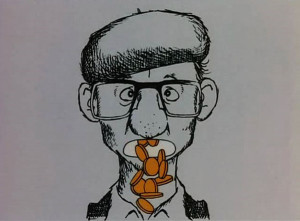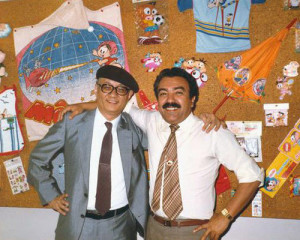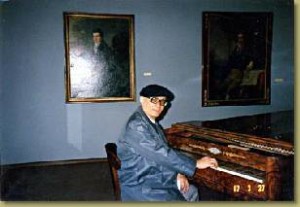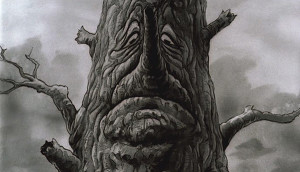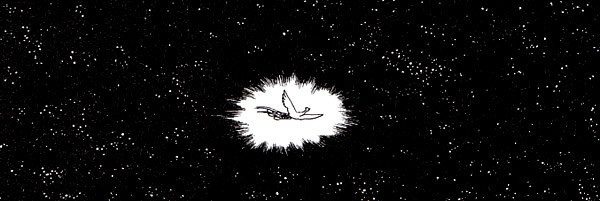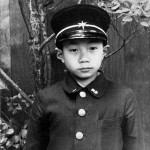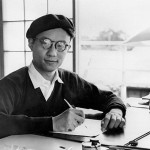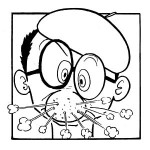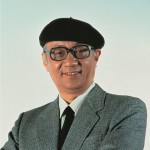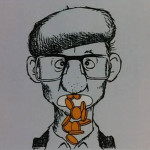Tezuka’s Life (1981-89)
In 1981, after giving a talk at a medical university, a medical researcher who had been in the audience contacted Tezuka and sent him some documents detailing his own family history in medicine. In fact, Osamu Tezuka is part of a medical dynasty of sorts. His great-great-grandfather, Ryoan Tezuka, considered the first modern army doctor in Japan, did much to introduce Western medical knowledge to Japan. This inspired Tezuka to create A Tree in the Sun (1981-86), a period medical drama – one which weaves historical fact and fiction in detailing the stories of Ryosen Tezuka and his son Ryoan Tezuka.
Throughout the 1980’s Tezuka continued to build connections with some of the great comic and animation artists from around the world. In early 1982, while attending an international comic art festival in France, he had the opportunity to meet the famous French comic artists, Jean Giraud, better known by his pen name, Moebius. Although Giraud did not know much about Japanese manga nor Osamu Tezuka, he found himself caught up in Tezuka’s enthusiasm and accepted an invitation to visit Japan later that summer.
I’m begging you… let me work”
In 1983 Tezuka released what would become his last great, completed, work – A Message to Adolf (1983-85). Based simply on a phrase he had once read in a book insinuating that the Nazi, Adolf Hitler, had Jewish blood, Tezuka wove a complex fictional tale of intrigue, murder and suspense that explores the Holocaust. The same month it began serialization, Tezuka’s mother, Fumiko Tezuka, passed away at the age of 74.
A short while later, and after a 16-year absence, Tezuka returned to the world of experimental animation and began working on Jumping (1984). Released in 1984, the short six-minute film shows the world from the point of view of a jumping child. With each jump the camera goes higher, and each landing holds a new surprise. Although he could not attend because of work commitments, Jumping (1984) won the Grand Prize at the 6th Zagreb International Animation Festival, held in 1984 in Croatia. It was the first time the prize had been won by someone from Japan.
In the fall, he continued to travel. At the request of the Japan Foundation, Tezuka traveled to Brazil for a series of lectures. There he met, and became friends with, the famed Brazilian comic artist, Mauricio de Sousa – something that was becoming something of a habit for Tezuka.
However, shortly after returning to Japan, Tezuka was hospitalized for two months with gallstones. During his hospitalization, his various publications and projects were suspended while he rested. Yet, as it was the first time he’d been seriously ill, to the point where he could not work, it gave Tezuka a bit of a new perspective. With the success of Jumping (1984) in mind, he decided he wanted to focus his energies on creating experimental animation works with international appeal. So, after returning to work in early 1985, he got started on Broken Down Film (1985). Premiering at the 1st Hiroshima International Animation Festival, it became the showpiece of the festival, winning the Grand Prix.
Later that same year, Japanese broadcasters NHK began filming Tezuka for a special behind-the-scenes documentary of the master at work. It was one of the rare occasions that film cameras were given almost unrestricted access to Tezuka’s private studio. Although the documentary showed viewers both his creative genius and tremendous stamina, it also uncovered some of his worries. A prime example of this was documenting the steady loss of his ability to draw nearly perfect circles unaided – a skill he had once been famous for. The documentary was originally aired on January 10, 1986 and has been since been released in English on a DVD extra included with Helen McCarthy’s wonderful book, The Art of Osamu Tezuka: God of Manga, (2009).
Shortly after the NHK documentary aired, in May 1986, just as Tezuka was beginning publication of what was to be the last chapter of his unfinished life’s work, Phoenix (1967-88), Chapter “Sun”, his father, Yutaka Tezuka also passed away at the age of 86. Although it was the last chapter of the Phoenix (1967-88) to see print, it was not intended by Tezuka to be the final chapter in the series. As the series had alternated between stories from the distant past to the farthest flung future, with each installment it had been getting ever closer to a final meeting in “the present”. For the next story Tezuka had intended it to be set during the Sino-Japanese war, however, tragically, it was not to be.
In 1987 Tezuka was once again traveling the world and, while visiting Austria, he had the opportunity to visit the Beethoven’s music room and sit at his piano. He was so moved by the experience that, after he returned to Japan and the magazine Comic Tom came looking for Tezuka to start a new series, he suggest doing a biographical manga on the life of Beethoven. Taking inspiration from the biographical film about Mozart, Amadeus, Tezuka decided to call the work Ludwig B (1987-89). As he set to work on the series, the expectation was that it was to be of similar length and scope as his earlier biographical manga, Buddha (1972-83).
Tezuka also, finally, began work on an idea he’d had wanted to work on since 1978, the experimental animated film, The Legend of the Forest (1987). Tezuka’s plan was to craft an environmental message to be presented using a number of techniques to chronicle the history of animation. The ambitious project was to be set to Tchaikovsky’s 4th symphony. Although, because of the complexity and scope, The Legend of the Forest (1987) could not be completed in time for the 2nd Hiroshima International Animation Festival, Tezuka was able to enter two shorter works, Push (1987) and Muramasa (1987).
Although the 1st and 4th movements of The Legend of the Forest (1987) were completed by the end of the year, by March 1988 was hospitalized due to stomach problems. He underwent an operation, was released, and in May returned to work. However, by the summer, his health was beginning to deteriorate. In November he and his wife, and some of his assistants, celebrated his 60th birthday during a visit to the “World of Osamu Tezuka” expedition at the museum in Kawasaki. A few days later he was off once again, this time to Shanghai, for another animation festival – as always with an editor trailing a few steps behind him hoping for a few last minute pages of artwork. Although the festival was a success, after his return to Japan he was once again hospitalized and underwent a second operation.
As 1989 rolled around, he was still working on his manga series such as Ludwig B (1987-89), Gringo (1987-89) and Neo Faust (1988-89), giving instructions to his assistants from his hospital bed. He was hoping to get well as soon as possible and get on with his many projects.
However, it was not to be. On February 9, 1989, Osamu Tezuka, known as the “God of Manga” died of stomach cancer, just a few short months after his 60th birthday.
Surrounded by his family, his final words were “I’m begging you… let me work”.

